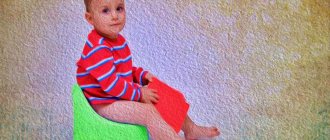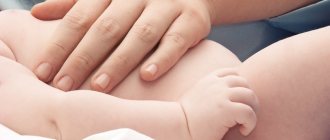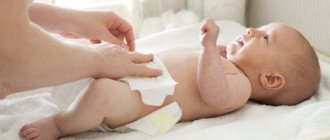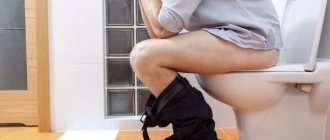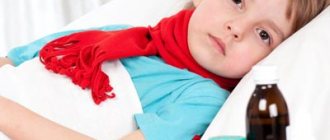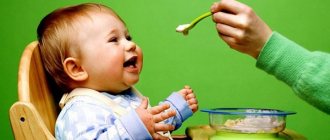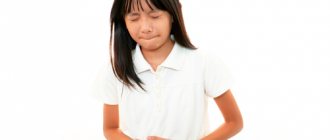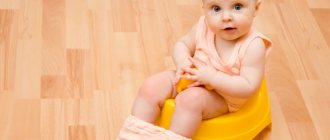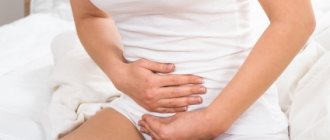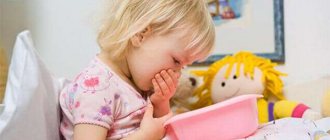Very often, baby stool turns out to be the main indicator of the functioning of the gastrointestinal tract and the baby’s health. The appearance of green diarrhea in a child at any age often becomes a cause of great concern for his parents.
In some cases, the presence of such feces is not accompanied by any changes in general well-being, but it happens that other symptoms are added to it, indicating the addition of the disease. How can you determine when you should worry about your child’s health?
Causes of loose green stool in a child
The child’s body often reacts by producing loose stools of an unnatural color, and if in newborns this phenomenon is associated with the peculiarities of digestion, with the introduction of complementary foods, then in children over three years old, green diarrhea is most often an alarming sign. The causes of loose, green-colored stool in babies can be:
- Including plenty of greens in your diet will give your poop a dark green hue. In addition, an excess of greens, like vegetables, often leads to digestive disorders, which is why a child may develop green diarrhea.
- The predominance of foods high in carbohydrates, these can be apples, potatoes, causing fermentation in the intestines.
- Food rich in iron.
- Too fatty food.
- Food poisoning.
- Treatment with antibiotics.
- Intestinal infections.
- Viral infections, even such as flu, sore throat, and the common cold, can cause diarrhea.
- Dysbacteriosis. In this case, the poop has not only a strange color and liquid consistency, but also a rather pungent putrid smell of feces.
- Digestive dysfunction.
- Inflammatory bowel diseases.
- Liver failure.
- Disruption of the gallbladder.
- Pathologies of the pancreas.
Preventive actions.
To avoid green diarrhea in your baby, you should follow certain rules:
- A nursing mother should follow a special diet and avoid taking antibiotics.
- For bottle-fed babies, formula should be selected only in accordance with the recommendations of the supervising specialist.
- Complementary feeding should be introduced gradually, temporarily excluding from the diet foods that cause the baby to form green stools.
- It is not recommended to overfeed older children with foods rich in simple carbohydrates.
- Adults should not lick cutlery intended for feeding, so as not to infect the child with an intestinal infection.
Associated symptoms of diseases that cause green diarrhea
Loose stools of a greenish tint, not accompanied by symptoms such as nausea, vomiting, pain and cramping in the abdominal area, gas formation, unpleasant odor of stool, fever, lethargy, weakness, lack of appetite, are usually associated with dietary habits, are not dangerous and go away quite quickly. fast. If these signs are detected in your baby, you should immediately seek the help of a pediatrician.
Here are some signs of serious pathological conditions:
- If the cause of green diarrhea in a child is inflammation of the intestines, for example, enterocolitis (inflammation of the small and large intestines), then the presence of pus and mucus can be observed in the poop. Body temperature also rises, vomiting and weakness appear.
- With dysbacteriosis, the liquid stool of babies takes on a green tint with a putrefactive aroma. In this case, vomiting and frequent urge to defecate often occur.
- Distal lesions in the intestine, accompanied by bleeding, cause the stool to turn dark green.
- The presence of intestinal infections is noteworthy in that loose stools, which have an unusual color, impurities of blood, mucus, foam, are always accompanied by nausea, vomiting, changes in body temperature, poor health of the baby and severe pain.
- Staining of stool can cause diseases of the liver, pancreas, gall bladder, and poisoning. In this case, prolonged vomiting, pain, and fever are observed.
Diagnostics
If the child feels unwell, call an ambulance. Doctors will determine the need for hospitalization, take measures to prevent complications and tell you about the procedure for further action.
When the child’s well-being allows it, they contact a pediatrician. The doctor will assess the child’s condition, find out the dietary habits, possible use of medications and study the history of early illnesses.
What tests are needed:
- general blood and urine tests;
- scatological examination of stool;
- blood chemistry;
- bacteriological study of feces and vomit;
- PCR analysis of feces and blood (if in doubt).
If gastrointestinal diseases are suspected, additional examination is prescribed:
- Ultrasound of the abdominal organs;
- colonoscopy;
- irrigoscopy;
- sigmoidoscopy;
- X-ray of the intestines.
For complicated infections, consultation with a cardiologist, nephrologist and urologist is necessary.
Why is green loose stool dangerous for a child?
First of all, diarrhea is dangerous due to dehydration, therefore, before visiting a doctor, you should provide your baby with plenty of fluids and carefully monitor his condition, since identifying the existing symptoms will help to more accurately determine the causes of diarrhea. Prolonged diarrhea also threatens the rapid loss of vitamins and mineral salts that are important for the body. And at an early age, severe dehydration and a lack of vital substances pose not only a health hazard, but are also a deadly threat. Loose stools caused by inflammatory processes in the intestines and diseases of other organs can become chronic if not treated in a timely manner, which will significantly complicate treatment. Intestinal poisoning, infectious and viral pathologies that cause diarrhea lead to severe intoxication, and the sooner treatment for the root cause is prescribed, the less toxic the effect on the child’s body will be.
Diarrhea Treatment Methods
Treatment of diarrhea should begin with taking saline solutions, such as Enterodes, Regidron - a teaspoon every hour. They will help restore water balance in the body, replenish salt levels, and also reduce the gag reflex. In case of poisoning, it is recommended to take activated carbon at the rate of one tablet per ten kilograms of the child’s body weight. Enterosgel or Smecta are also suitable sorbents. You can use a weak solution of potassium permanganate; this is an excellent remedy for washing the stomach and removing toxins. If the baby suffers from pain, antispasmodics are used: No-shpa, Papaverine (dosage for different ages is indicated in the annotation). You can try to relieve your child's abdominal cramps with massage. To do this, you need to make circular movements over the stomach with your hands, but under no circumstances apply pressure.
But these are only means to eliminate the symptoms of diarrhea. Treatment of the root cause of diarrhea should be carried out under the supervision of a physician and only after appropriate laboratory testing. For diarrhea, especially caused by taking antibiotics, probiotics and prebiotics are usually prescribed to normalize the intestinal microflora. These drugs include: Bifidumbacterin, Hilak Forte, Lactobacterin, etc.
Traditional methods of treating loose stools
Folk recipes have been tested for decades and many generations; they are used as an alternative to medications or as an additional remedy for illness. But it is always important to follow the dosage. The most common recipes for eliminating the symptoms of diarrhea in babies are:
- An infusion of chamomile and mint flowers has remarkable antispasmodic and antiseptic properties. Chamomile and mint are mixed in equal quantities. To prepare the infusion, you will need one teaspoon of the mixture per glass of hot water. The product will be ready in half an hour. The entire volume should be drunk during the day in five doses.
- Rice water in a ratio of one to three (rice and water). The rice should be completely cooked. Children are given half a glass every two hours. If there is severe vomiting, take a sip every half hour.
- Pour an ordinary cuff, one teaspoon in volume, into two glasses of boiling water. The product should stand until it cools. Children's dosage – a few sips per day.
- Fifteen grams of hawthorn fruits are poured into a glass of water and heated in a water bath for ten minutes. Children are recommended to drink from fifty to one hundred milliliters (depending on age) three times a day.
Helping a child
Before doctors arrive or visit a doctor at home, you need to provide first aid to your baby. At the same time, pay attention to actions that should not be taken in relation to the baby during diarrhea.
First aid methods
If green diarrhea is detected in a child without additional symptoms, preventive action is required. Parents should contact their pediatrician. Afterwards, the baby will be prescribed tests. If dysbiosis is detected, the child is prescribed vitamin complexes and means to restore the immune system.
If a child complains of abdominal pain and at the same time has bouts of vomiting, then call an ambulance. This may indicate a risk of developing an intestinal infection. Therefore, it will be difficult to get to the hospital on your own.
If the body is dehydrated, after examination by a doctor, a drip is prescribed. Parents are advised to give their baby more water. In addition, they are advised about introducing a therapeutic diet so as not to provoke the intestines into another disorder. Proper nutrition consists of strict principles that include prohibited foods.
To determine the cause of diarrhea, the baby needs to be diagnosed by a pediatrician. The child will be prescribed a series of laboratory tests. After making a diagnosis, the doctor will prescribe a comprehensive treatment. Therapy includes diet and medications. Medicines are prescribed only those that help restore intestinal microflora and electrolyte balance.
If your child experiences green diarrhea, you should not use home remedies without first consulting a doctor.
What actions should a child not do if he or she is unwell?
When your baby has green diarrhea, you should not self-medicate. This can worsen the child's condition. Therefore, under no circumstances should you give painkillers to relieve abdominal discomfort. Parents should pay attention to taking antibiotics. You should not give such products to your baby. Tetracycline drugs are toxic medications for children. This can cause poisoning in children.
If a child has lost his appetite, then you should not force him to eat. Many foods and dishes with diarrhea and diseases will cause the disorder to worsen. If you have diarrhea, you should not limit your fluid intake. It is noted that raw vegetables and fruits should not be given from food.
Diet for diarrhea
A diet for diarrhea on the first day implies the absence of food, which is replaced with drink or a decrease in the usual volume. You need to drink often, but in small portions. Instead of water, you can use decoctions or infusions of chamomile, rose hips, weak green tea (only without sugar), which will replenish the water balance and supply of microelements.
The following should be excluded from the diet:
- fatty, highly salty and sour foods;
- seasonings;
- smoked meats;
- carbonated drinks and juices;
- fruits and vegetables;
- sweets;
- pasta and flour products;
- dairy products.
Unsalted rice and oatmeal porridges are recommended. As the condition improves, steamed meat products, lean fish and poultry, soups, and fermented milk products are gradually introduced into the child’s diet.
Prevention of diarrhea
Compliance with preventive measures will avoid many problems. And for this it is important to adhere to several rules:
- From an early age, a child should learn to wash his hands after a walk, visiting the toilet, contact with animals, and before eating. It is important to keep toys and places where your baby likes to play clean.
- Fruits and vegetables should be washed thoroughly, it is better to douse them with boiling water.
- Food must be fresh.
- Make sure your child chews his food well.
- You should not drink raw water.
- Check expiration dates on products.
